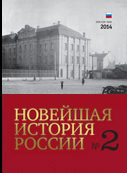ИЗ ИСТОРИИ АНТИРЕЛИГИОЗНОЙ МУЗЕЙНОЙ КАМПАНИИ: ВЫСТАВКА «САМОДЕРЖАВИЕ И ЦЕРКОВЬ» В ЦЕРКОВНОМ КОРПУСЕ БОЛЬШОГО ПЕТЕРГОФСКОГО ДВОРЦА
The Anti-Religious Museum Campaign: Exhibition “Autocracy and Church” in the Church of Peterhof Grand Palace
Author(s): I. V. Petrov, S. V. Bondarev Subject(s): Cultural history
Published by: Издательство Исторического факультета СПбГУ
Keywords: ORTHODOX CHURCH; ATHEISM; ANTI-RELIGIOUS POLICY; MUSEUMS; PETERHOF
Summary/Abstract: This paper deals with an important aspect of the anti-religious policy of the Soviet government: anti-clerical museums and exhibitions, which started appearing immediately after the Bolsheviks came to power. Special attention is paid to the exhibition “Autocracy and the Church”, held in the State Museum “Peterhof” in the first half of the 1930s. The article deals with every single aspect of the exhibition, talking about various connections between the Orthodox Church and the pre-revolutionary government: Church and Army, the deification of imperial power and the tsars themselves, the role of the Orthodox clergy in the struggle against the revolutionary movement, the material basis for the existence of the Russian Orthodox Church, and various other connections. The authors pay special attention to presenting the creators and curators of the post-October period of the history of the Orthodox Church in the context of violent confrontation between the new atheist regime and the largest religious denomination in the Soviet Union. Separately, it should be noted that the authors studied two types of anti-religious exhibitions and museums: the idea of creating “atheistic red laurels” arose almost immediately the Bolsheviks came to power, but for reasons unknown it remained unrealized. The second option came later, but at the same time was more ideologically aligned. And, if in the first case, you can see a kind of “opportunistic”, creative approach to these kinds of museum exhibitions, already in the 1930s you can see more visible, systematic and professional work of the exhibition organizers in one of the main museums in our country. Also, the practical significance of this paper is that it is one of the first integrated treatments of the anti-religious campaign through the study of atheist museums and exhibitions.
Journal: Новейшая история России
- Issue Year: 4/2014
- Issue No: 10
- Page Range: 117-127
- Page Count: 11
- Language: Russian

